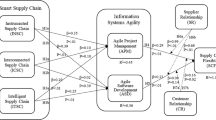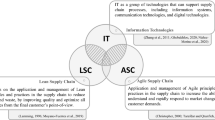Abstract
This article reports a structural equation model (SEM) with four latent variables to measure the relationship between information and communication technologies (ICT) integration with supply chain flexibility, supply chain agility, and company’s performance. The SEM integrates six hypotheses with relationships among variables and is validated with 378 responses from manufacturing sector to a questionnaire and partial least squares technique is used to evaluate it and test the hypotheses statistically. A sensitivity analysis is conducted in different scenarios to know conditional probabilities of occurrence of dependent variables, since a scenario has occurred in the independent variable with low and high success level. Findings indicate that ICT integration in supply chain facilitate to monitoring the production process, partners integration and have a direct effect on agility and flexibility for manufacturers, providing an active material’ or subassemblies’ flow among partners with greater visibility and making agile and joint decision-making.


Similar content being viewed by others
References
Mensah, P., Merkuryev, Y., Klavins, E., & Manak, S. (2017). Supply chain risks analysis of a logging company: Conceptual model. Procedia Computer Science, 104, 313–320. https://doi.org/10.1016/j.procs.2017.01.140.
Mota-López, D. R., Sánchez-Ramírez, C., Alor-Hernández, G., García-Alcaraz, J. L., & Rodríguez-Pérez, S. I. (2019). Evaluation of the impact of water supply disruptions in bioethanol production. Computers & Industrial Engineering, 127, 1068–1088. https://doi.org/10.1016/j.cie.2018.11.041.
Samdantsoodol, A., Cang, S., Yu, H., Eardley, A., & Buyantsogt, A. (2017). Predicting the relationships between virtual enterprises and agility in supply chains. Expert Systems with Applications, 84(3), 58–73. https://doi.org/10.1016/j.eswa.2017.04.037.
Bargshady, G., Zahraee, S. M., Ahmadi, M., & Parto, A. (2016). The effect of information technology on the agility of the supply chain in the Iranian power plant industry. Journal of Manufacturing Technology Management, 27(3), 427–442. https://doi.org/10.1108/JMTM-11-2015-0093.
Garcia-Alcaraz, J. L., Maldonado-Macias, A. A., Alor-Hernandez, G., & Sanchez-Ramirez, C. (2017). The impact of information and communication technologies (ICT) on agility, operating, and economical performance of supply chain. Advances in Production Engineering & Management, 12(1), 29–40. https://doi.org/10.14743/apem2017.1.237.
Monsreal-Barrera, M. M., Cruz-Mejia, O., Ozkul, S., & Saucedo-Martínez, J. A. (2019). An optimization model for investment in technology and government regulation. Wireless Networks, 8, 8–9. https://doi.org/10.1007/s11276-019-01958-z.
Monostori, J. (2018). Supply chains robustness: Challenges and opportunities. Procedia CIRP, 67, 110–115. https://doi.org/10.1016/j.procir.2017.12.185.
Mensah, P., Merkuryev, Y., & Longo, F. (2015). Using ICT in developing a resilient supply chain strategy. Procedia Computer Science, 43, 101–108. https://doi.org/10.1016/j.procs.2014.12.014.
Zhang, Q., & Cao, M. (2018). Exploring antecedents of supply chain collaboration: Effects of culture and interorganizational system appropriation. International Journal of Production Economics, 195, 146–157. https://doi.org/10.1016/j.ijpe.2017.10.014.
Swafford, P. M., Ghosh, S., & Murthy, N. (2008). Achieving supply chain agility through IT integration and flexibility. International Journal of Production Economics, 116(2), 288–297. https://doi.org/10.1016/j.ijpe.2008.09.002.
Mahalik, N., & Kim, K. (2016). The role of information technology developments in food supply chain integration and monitoring. In C. E. Leadley (Ed.), In Innovation and future trends in food manufacturing and supply chain technologies (pp. 21–37). Cambridge: Woodhead Publishing.
Marinagi, C., Trivellas, P., & Sakas, D. P. (2014). The impact of information technology on the development of supply chain competitive advantage. Procedia-Social and Behavioral Sciences, 147(Supplement C), 586–591. https://doi.org/10.1016/j.sbspro.2014.07.161.
Caridi, M., Moretto, A., Perego, A., & Tumino, A. (2014). The benefits of supply chain visibility: A value assessment model. International Journal of Production Economics, 151(Supplement C), 1–19. https://doi.org/10.1016/j.ijpe.2013.12.025.
Costantino, N., Dotoli, M., Falagario, M., Fanti, M. P., & Mangini, A. M. (2012). A model for supply management of agile manufacturing supply chains. International Journal of Production Economics, 135(1), 451–457. https://doi.org/10.1016/j.ijpe.2011.08.021.
Jaaskelainen, A., & Hirn, J. (2016). Data-driven business integration in procurement: A case study in an ICT Company. In G. S. Erickson, & H. N. Rothberg (Eds.), Proceedings of the 13th international conference on intellectual capital knowledge management & organisational learning (pp. 128–135). Nr Reading: Acad Conferences Ltd.
Bohtan, A., Vrat, P., & Vij, A. K. (2017). Supply chain of the Indian public distribution system: A new paradigm. Journal of Advances in Management Research, 14(1), 110–123. https://doi.org/10.1108/jamr-09-2015-0065.
Ramadan, M., Al-Maimani, H., & Noche, B. (2017). RFID-enabled smart real-time manufacturing cost tracking system. The International Journal of Advanced Manufacturing Technology, 89(1), 969–985. https://doi.org/10.1007/s00170-016-9131-1.
Ibrahim, A., & Dalkılıc, G. (2019). Review of different classes of RFID authentication protocols. Wireless Networks, 25(3), 961–974. https://doi.org/10.1007/s11276-017-1638-3.
Liu, Z., Li, K. W., Li, B.-Y., Huang, J., & Tang, J. (2019). Impact of product-design strategies on the operations of a closed-loop supply chain. Transportation Research Part E: Logistics and Transportation Review, 124, 75–91. https://doi.org/10.1016/j.tre.2019.02.007.
Wang, H., Gong, Q., & Wang, S. (2017). Information processing structures and decision making delays in MRP and JIT. International Journal of Production Economics, 188, 41–49. https://doi.org/10.1016/j.ijpe.2017.03.016.
Fayezi, S., Zutshi, A., & O’Loughlin, A. (2015). How Australian manufacturing firms perceive and understand the concepts of agility and flexibility in the supply chain. International Journal of Operations & Production Management, 35(2), 246–281. https://doi.org/10.1108/IJOPM-12-2012-0546.
Asad, M. M., Mohammadi, V., & Shirani, M. (2016). Modeling flexibility capabilities of IT-based supply chain, using a grey-based DEMATEL method. Procedia Economics and Finance, 36, 220–231. https://doi.org/10.1016/S2212-5671(16)30033-8.
Ravichandran, T. (2017). Exploring the relationships between IT competence, innovation capacity and organizational agility. The Journal of Strategic Information Systems. https://doi.org/10.1016/j.jsis.2017.07.002.
García-Alcaraz, J. L., Maldonado-Macías, A. A., Hernandez, G. A., Jiménez-Macías, E., Muro, J. C. S. D., & Blanco-Fernández, J. (2017). Impact of human factor on flexibility and supply chain agility of La Rioja wineries. European Journal of Industrial Engineering, 11(5), 663–682. https://doi.org/10.1504/ejie.2017.087703.
Ngai, E. W. T., Chau, D. C. K., & Chan, T. L. A. (2011). Information technology, operational, and management competencies for supply chain agility: Findings from case studies. The Journal of Strategic Information Systems, 20(3), 232–249. https://doi.org/10.1016/j.jsis.2010.11.002.
Liu, H., Ke, W., Wei, K. K., & Hua, Z. (2013). The impact of IT capabilities on firm performance: The mediating roles of absorptive capacity and supply chain agility. Decision Support Systems, 54(3), 1452–1462. https://doi.org/10.1016/j.dss.2012.12.016.
Chan, A. T. L., Ngai, E. W. T., & Moon, K. K. L. (2017). The effects of strategic and manufacturing flexibilities and supply chain agility on firm performance in the fashion industry. European Journal of Operational Research, 259(2), 486–499. https://doi.org/10.1016/j.ejor.2016.11.006.
Iqbal, T., Huq, F., & Bhutta, M. K. S. (2018). Agile manufacturing relationship building with TQM, JIT, and firm performance: An exploratory study in apparel export industry of Pakistan. International Journal of Production Economics, 203, 24–37. https://doi.org/10.1016/j.ijpe.2018.05.033.
Wu, K.-J., Tseng, M.-L., Chiu, A. S. F., & Lim, M. K. (2017). Achieving competitive advantage through supply chain agility under uncertainty: A novel multi-criteria decision-making structure. International Journal of Production Economics, 190, 96–107. https://doi.org/10.1016/j.ijpe.2016.08.027.
Garcia-Alcaraz, J. L., Maldonado-Macias, A. A., Hernandez-Arellano, J. L., Blanco-Fernandez, J., Jimenez-Macias, E., & Saenz-Diezuro, M. J. C. (2017). The impact of human resources on the agility, flexibility and performance of wine supply chains. Agricultural Economics Czech Republic, 63(4), 175–184. https://doi.org/10.17221/23/2016-AGRICECON.
Mark, S., & Martin, S. (2007). Flexibility from a supply chain perspective: Definition and review. International Journal of Operations & Production Management, 27(7), 685–713. https://doi.org/10.1108/01443570710756956.
Sanchez, A. M., Perez, M. P., & Oliva, S. V. (2018). Agility, production flexibility and innovation in the Spanish manufacturing company. Direccion Y Organizacion, 65, 60–71.
Gligor, D. M., Esmark, C. L., & Holcomb, M. C. (2015). Performance outcomes of supply chain agility: When should you be agile? Journal of Operations Management, 33–34(Supplement C), 71–82. https://doi.org/10.1016/j.jom.2014.10.008.
DeGroote, S. E., & Marx, T. G. (2013). The impact of IT on supply chain agility and firm performance: An empirical investigation. International Journal of Information Management, 33(6), 909–916. https://doi.org/10.1016/j.ijinfomgt.2013.09.001.
Pérez-López, R. J., Olguín-Tiznado, J. E., García-Alcaraz, J. L., Camargo-Wilson, C., & López-Barreras, J. A. (2018). The role of planning and implementation of ICT in operational benefits. Sustainability, 10(7), 2261. https://doi.org/10.3390/su10072261.
Zhang, X., & Yang, X. (2016). How inter-organizational ICT impact on supply chain performance with considering supply chain integration and uncertainty. In International conference on logistics, informatics and service sciences. Sydney, NSW. https://doi.org/10.1109/LISS.2016.7854370.
Claro, D. P., Vojnovskis, D., & Ramos, C. (2018). When channel conflict positively affect performance: Evidence from ICT supplier-reseller relationship. Journal of Business & Industrial Marketing, 33(2), 228–239. https://doi.org/10.1108/jbim-11-2016-0272.
Sreedevi, R., & Saranga, H. (2017). Uncertainty and supply chain risk: The moderating role of supply chain flexibility in risk mitigation. International Journal of Production Economics, 193, 332–342. https://doi.org/10.1016/j.ijpe.2017.07.024.
Filho, M. G., & Utiyama, M. H. R. (2016). Comparing the effect of different strategies of continuous improvement programmes on repair time to reduce lead time. The International Journal of Advanced Manufacturing Technology, 87(1), 315–327. https://doi.org/10.1007/s00170-016-8483-x.
Altendorfer, K. (2017). Relation between lead time dependent demand and capacity flexibility in a two-stage supply chain with lost sales. International Journal of Production Economics, 194, 13–24. https://doi.org/10.1016/j.ijpe.2017.05.007.
Kisperska-Moron, D., & de Haan, J. (2011). Improving supply chain performance to satisfy final customers: “Leagile” experiences of a polish distributor. International Journal of Production Economics, 133(1), 127–134. https://doi.org/10.1016/j.ijpe.2009.12.013.
Avelar-Sosa, L., García-Alcaraz, J., Mejía-Muñoz, J., Maldonado-Macías, A., & Hernández, G. (2018). Government support and market proximity: Exploring their relationship with supply chain agility and financial performance. Sustainability, 10(7), 2441. https://doi.org/10.3390/su10072441.
Tse, Y. K., Zhang, M., Akhtar, P., & MacBryde, J. (2016). Embracing supply chain agility: An investigation in the electronics industry. Supply Chain Management: An International Journal, 21(1), 140–156. https://doi.org/10.1108/SCM-06-2015-0237.
Likert, R. (1932). A technique for the measurement of attitudes. Archives of Psychology, 22(140), 1–55.
Hair, J. F., Hult, G. T. M., Ringle, C., & Sarstedt, M. (2016). A primer on partial least squares structural equation modeling (PLS-SEM). Thousand Oaks: SAGE Publications.
Kock, N. (2015). WarpPLS 5.0 user manual. ScriptWarp Systems. Laredo, TX.
Evermann, J., & Tate, M. (2016). Assessing the predictive performance of structural equation model estimators. Journal of Business Research, 69(10), 4565–4582. https://doi.org/10.1016/j.jbusres.2016.03.050.
Ekrot, B., Kock, A., & Gemünden, H. G. (2016). Retaining project management competence—Antecedents and consequences. International Journal of Project Management, 34(2), 145–157. https://doi.org/10.1016/j.ijproman.2015.10.010.
Sarstedt, M., Ringle, C. M., Smith, D., Reams, R., & Hair, J. F. (2014). Partial least squares structural equation modeling (PLS-SEM): A useful tool for family business researchers. Journal of Family Business Strategy, 5(1), 105–115. https://doi.org/10.1016/j.jfbs.2014.01.002.
Jorgenson, D. W., & Vu, K. M. (2016). The impact of ICT investment on world economic growth. Telecommunications Policy, 40(5), 381–382. https://doi.org/10.1016/j.telpol.2016.02.006.
Moon, K. K.-L., Yi, C. Y., & Ngai, E. W. T. (2012). An instrument for measuring supply chain flexibility for the textile and clothing companies. European Journal of Operational Research, 222(2), 191–203. https://doi.org/10.1016/j.ejor.2012.04.027.
Acknowledgement
The authors thanks the managers, engineers and people who work in the industry and who answered our questionnaire. Without their support, this paper would not have been possible.
Funding
This work was supported by the Mexican National Council for Science and Technology (CONACyT) for its support under project CONACYT-INS (REDES) 2018 - 293683 LAS.
Author information
Authors and Affiliations
Corresponding author
Ethics declarations
Conflict of interest
The authors declare that they have no conflict of interest.
Additional information
Publisher's Note
Springer Nature remains neutral with regard to jurisdictional claims in published maps and institutional affiliations.
Electronic supplementary material
Below is the link to the electronic supplementary material.
Rights and permissions
About this article
Cite this article
García-Alcaraz, J.L., Martínez-Loya, V., Díaz-Reza, J.R. et al. Effect of ICT integration on SC flexibility, agility and company’ performance: the Mexican maquiladora experience. Wireless Netw 26, 4805–4818 (2020). https://doi.org/10.1007/s11276-019-02068-6
Published:
Issue Date:
DOI: https://doi.org/10.1007/s11276-019-02068-6




